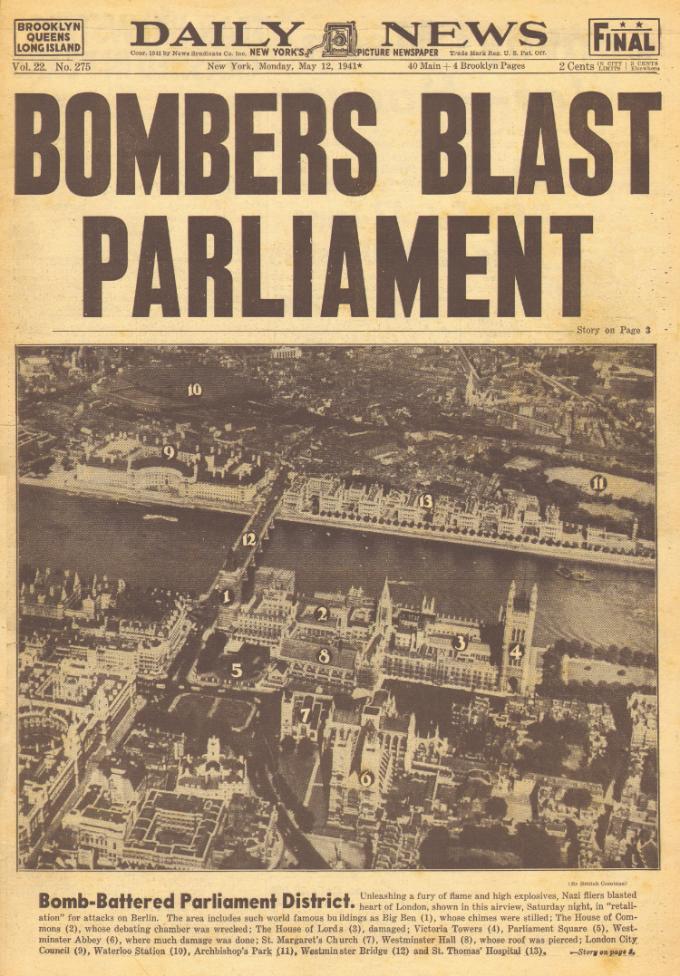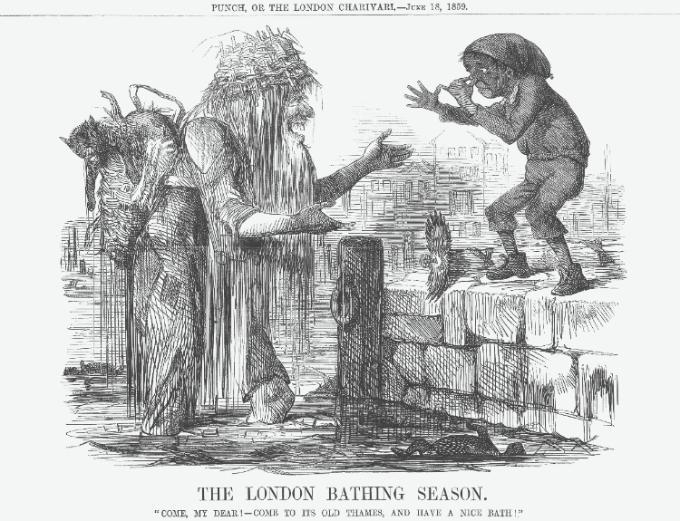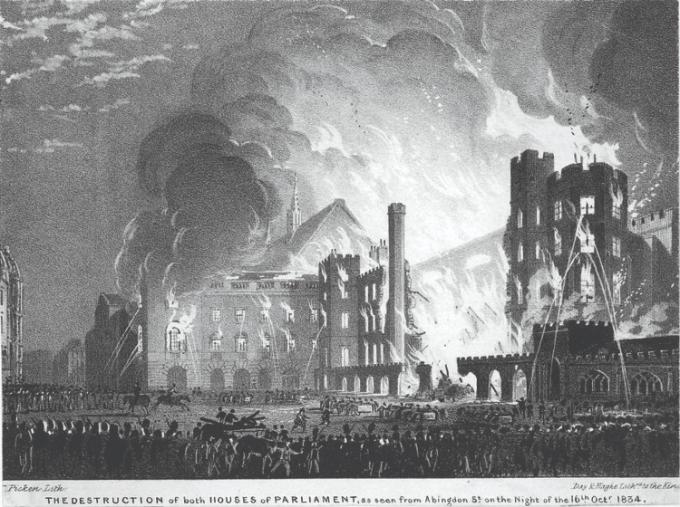The Blitz, a blaze and that terrible pong: parliamentary disasters of the past
Damage to the House of Commons during the Blitz, December 1940 | Alamy
6 min read
Although Covid restrictions have thrown a sizable spanner in the constitutional works, perhaps today’s parliamentarians should think themselves lucky to have dodged a number of other historical hazards.
At 3.09pm on 21 April 2020, the Conservative peer Lord Balfe made history by appearing remotely in Lords’ Questions. Dudley North MP Marco Longhi followed suit in the Commons the next day. It was the start of a revolution triggered by one of the most disruptive events in world history: the Covid-19 pandemic.
From the use of proxies to the “conga line” voting system in the summer of 2020, Covid brought seismic changes to the working life of everyone in the Palace of Westminster. Perhaps the high point of the hybrid Parliament was Lord Robathan’s contribution in July 2020 from a taxi returning from lunch – very good restaurant, he enthusiastically told us.
However, coronavirus is only the latest disaster to bring disruption to the lives of MPs and peers in Parliament’s long history.
The Second World War
 Perhaps the most testing time Parliament has ever known, the Blitz forced both Houses to move to Church House in Dean’s Yard. Between 1940 and 1941, the Lords inhabited Convocation Hall and the Commons the Hoare Memorial Hall. Parliament met there on six occasions, including the State Opening on 21 November 1940, which was not without incident. After being dispatched by the King, Black Rod became hopelessly lost trying to find the Commons. Police lined the route but when he approached to ask for directions, they emitted a loud cry of “Make way for Black Rod.” Traditional, but not entirely helpful.
Perhaps the most testing time Parliament has ever known, the Blitz forced both Houses to move to Church House in Dean’s Yard. Between 1940 and 1941, the Lords inhabited Convocation Hall and the Commons the Hoare Memorial Hall. Parliament met there on six occasions, including the State Opening on 21 November 1940, which was not without incident. After being dispatched by the King, Black Rod became hopelessly lost trying to find the Commons. Police lined the route but when he approached to ask for directions, they emitted a loud cry of “Make way for Black Rod.” Traditional, but not entirely helpful.
From late June 1941, the Houses returned to the Palace of Westminster. But as the Commons had been destroyed by a bombing raid, MPs met in the Lords chamber, and the Lords in the Robing Room next door. The Houses did not return to their own chambers until October 1950, although George VI marked VJ-Day on 15 August 1945 by delivering the King’s Speech from the throne in the Lords.
Spanish Flu
The Spanish flu outbreak of 1918 to 1920 was the deadliest pandemic of the 20th century and caused 228,000 deaths in the UK alone. It was similar to coronavirus in terms of infectiousness yet, unlike today, Parliament made no concessions whatsoever.
The pandemic was first identified in troops in Kansas in the United States and spread wildly on the fighting fields of Europe. The press was censored in the combatant nations, so neutral Spain was unfairly bestowed with ownership of the virus following reports that its king and prime minister had been struck down. The flu went on to infect a third of the planet, killing an estimated 50 million people.
The Thames had always been a bit whiffy, but soaring temperatures in 1858 caused the sewage to cook, like a noxious soup
Lloyd George was felled by it on 12 September 1918 while visiting Manchester. The PM spent 10 days in a sick bed at the town hall, much of the time hooked up to a ventilator. His valet whispered it was touch and go – but the press stayed silent to protect morale.
The first mention of the flu in Hansard was not until 29 October 1918, when the minister for national service, Cecil Beck, was asked “to provide an adequate medical service for the civilian population”. A day later, Eskdale MP Claude Lowther asked: “Is it a fact that a sure preventative against influenza is cocoa taken three times a day?”
The Great Stink

If the 30-degree heatwave experienced by parts of the UK this July felt oppressive, have sympathy for our Victorian predecessors who endured higher temperatures and an overwhelming stench during the summer of 1858.
The Great Stink proved massively debilitating, as the overpowering foul smell made working in the Palace almost impossible.
The cause was tonnes of human, animal and industrial waste dumped into the Thames over the preceding centuries. Summers by the Thames had always been a bit whiffy, but soaring temperatures in 1858 causing something far worse – the sewage began to cook, like a noxious and highly toxic soup.
The Thameside rooms of the Palace were abandoned when dousing the curtains in chloride and lime proved ineffective, and consideration was given to removing the government from Westminster altogether.
Relief came in the form of the Metropolis Local Management Amendment Bill published by Benjamin Disraeli on 15 June 1858. The result was Sir Joseph Bazalgette’s plan for more than 1,000 miles of sewers to take the effluent to the east of London, where it could flow into the estuary with the tide, taking everything out to sea. It was seven smelly years before the project was opened by the Prince of Wales.
The Great Fire
There had been warnings for years about the risk of the ramshackle Palace of Westminster going up in flames (sound familiar?). On the night of 16 October 1834 it happened, due to ineptitude.

For centuries, the Exchequer had used hazel tally sticks to register debts. This accounting system became obsolete in 1826 and, eight years later, it was decided to burn the sticks – two cartloads of bone-dry tinder. The clerk of works thought the stoves beneath the Lords would be ideal for the job. Following an afternoon of increasing heat and smoke, fire broke out at 6pm and swiftly engulfed the Palace.
Crowds rushed to watch the carnage – a spectacular scene captured on canvas by JMW Turner. There was extensive damage and the more modern wooden buildings vanished entirely. During the long restoration, the Lords moved to the Painted Chamber, and the Commons into the Court of Requests.
It would be six years until the foundation stone for the new building was laid. Peers finally moved into their glittering chamber in 1847, while the new Commons was not ready until 1852, when Queen Victoria performed the opening ceremony.
The Great Plague
Plague was the major killer of the 17th century with an outbreak in 1625 forcing parliament to take refuge at Oxford University. Charles II and his parliament followed suit 40 years later when they headed to Oxford during the Great Plague, which raged between 1665 and 1666.
Students were told to stay away while parliament took over colleges and local inns. The royal court took up residence at Christchurch, and parliament sat in the Bodleian Library. For the town’s inhabitants, their departure was a relief, with one scholar describing the visitors as: “Rude, rough, whoremongers; vain, empty and careless.”
The Black Death
The greatest plague suffered in these islands killed around half the population – and Parliament was not spared.
Before the Reformation, parliaments met for only short periods, usually to grant taxation. Following the dissolution of 13 April 1348 there was no session until Parliament was opened by Royal Commission on 9 February 1351, a notably long interval which is attributed to the Black Death. In the Lords, three Archbishops of Canterbury died in quick succession from 1348 to 1349.
Plague returned many times over the ensuing centuries and an outbreak between 1467 and 1468 led to Parliament being disbanded in disarray following the deaths of a number of MPs and peers.
